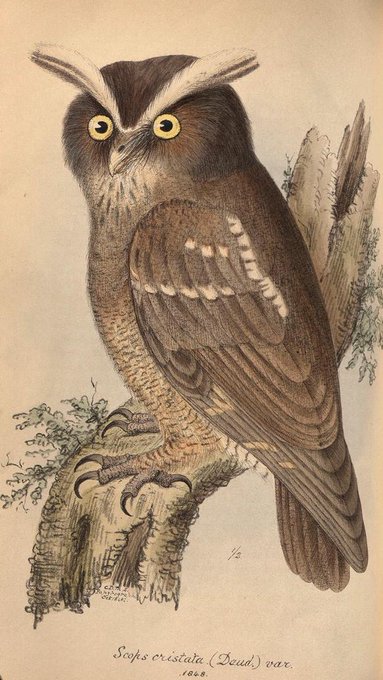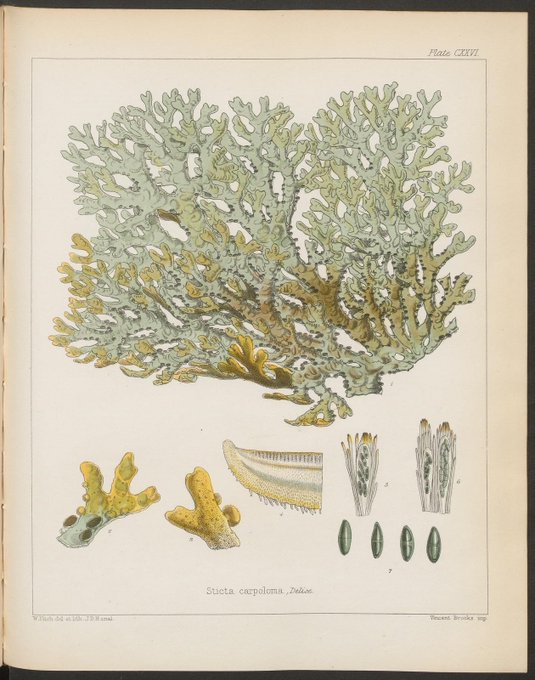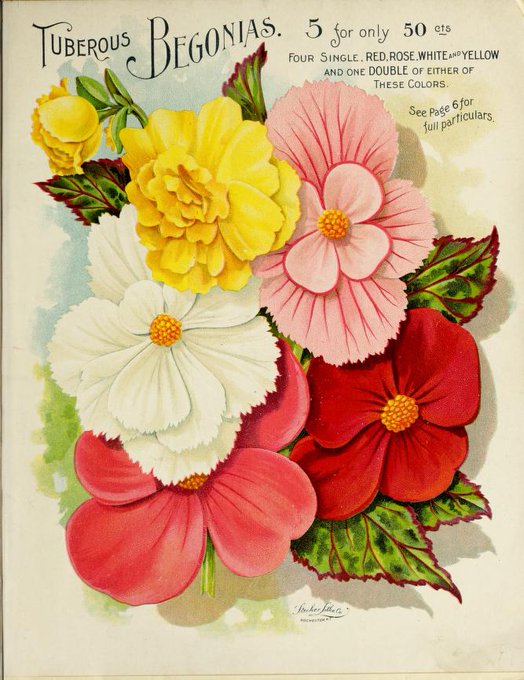BHLibのTwitterイラスト検索結果。 357 件中 10ページ目
John Lindley became known as the “father of modern orchidology”. For #FloraFriday, explore his "Illustrations of Orchidaceous Plants" (1830-38), which features #SciArt by Franz Bauer and was recently digitized in #BHLib by @NHM_Library ➡️ https://t.co/FoAVjURJfY
August Batsch's "Analyses florum e diversis plantarum generibus" (1790) features text in Latin & German + 20 plates based on drawings by Batsch to help illustrate the morphology of various plants. View in #BHLib via @HarvardLibrary ➡️ https://t.co/H50cnSWFTJ #FloraFriday 🌺🌼🌸
German naturalist Eduard Rüppell embarked on an expedition to northern Africa in the 1820s. The specimens collected were used to produce "Atlas zu der Reise im nordlichen Afrika" (1826-28). Explore it in #BHLib via @FieldMuseum ➡️ https://t.co/6KNfuqFYbs #WildlifeWednesday
For #BotanicMonday, explore chromolithographic proof impressions of #orchid watercolor drawings, unsigned but possibly by H.G Moon & probably destined for a 3rd series of Frederick Sander's "Reichenbachia." #OpenAccess in #BHLib via@chicagobotanic ➡️ https://t.co/cdXeQMZV0b
"Contributions to Ornithology" (1848-1852) by Sir William Jardine was the 1st ornithological periodical produced in Britain. Jardine's daughter Catherine produced much of the work's #SciArt. Explore it in #BHLib for #Feathursday thanks to @AcadNatSci ➡️ https://t.co/7pQPxtRMCr
Which plants & animals to choose for your aquarium? Humphreys' "Ocean Gardens: The History of the Marine Aquarium" (1857) offered advice on creating & maintaining indoor “ocean gardens." Find it in #BHLib via @Fisher_Library @uoftlibraries ➡️ https://t.co/BXgajzFJ5R
With the holidays approaching, you may expect to see a Christmas Rose (Helleborus niger), but #DYK this species is poisonous? 😳 #SciArt by Sydenham Edwards for Curtis's "Botanical Magazine" v. 1 (1787), in #BHLib via @mobotgarden ➡️ https://t.co/xgi7i5gtWz #BotanicMonday
We're shell-ebrating #MolluskMonday with beautiful shell #SciArt! "Thesaurus conchyliorum, or, Monographs of genera of shells" (1847-87) is considered one of the rarest of all conchology books. It's freely available in #BHLib via @SILibraries ➡️ https://t.co/HuHUVymzYj 🐚🐚🐚
J.D. Hooker's "Flora Antarctica" describes plants discovered on the Ross expedition (1839–1843), which visited islands off the coast of the Antarctic continent. Explore it in #BHLib via @HarvardLibrary @MBLWHOILibrary @mobotgarden for #BotanicMonday ➡️ https://t.co/iBdFP31hCV
"The songs of birds may be considered as national melodies, for each has its own peculiar music." 🎶 Explore #birds through poems and #SciArt this #Feathursday with "The Language of Birds" (1837) by Mrs. George Spratt, in #BHLib via @FieldMuseum ➡️ https://t.co/qxPumqYMx7
The western spinebill (Acanthorhynchus superciliosus) and the tawny-crowned honeyeater (Gliciphila melanops) for #Feathursday! #SciArt by Henrik Grönvold from v. 11 (1923-24) of "The Birds of Australia". In #BHLib via @museumsvictoria @bhl_au ➡️ https://t.co/BOPDxvKRxW
Nymphaeaceae for #BotanicMonday! This #SciArt is from the 1868 quarto edition of "Illustrations of the Natural Order of Plants" by Elizabeth Twining (of the @TwiningsTeaUK family). It is available in #BHLib thanks to @IllinoisLibrary ➡️ https://t.co/4kxW8DfRxT #WomenInScience
Explore "The Floral Magazine" (1860-1881) for #BotanicMonday! Illustrators for this publication on popular garden plants included John Nugent Fitch, Walter Hood Fitch, James Andrews, and Worthington George Smith. Find it in #BHLib via @NYBG & @SILibraries: https://t.co/syxGKoa4LS
Tausch's "Hortus Canalius" (1823) describes and illustrates a selection of the plants found at the botanical garden of Emanuel Joseph Malabaila von Canal. It features #SciArt lithographed after F. Both. Explore the work in #BHLib via @HarvardLibrary ➡️ https://t.co/vYmiWxL8gX
Happy #Feathursday! "Iconographie des perroquets" (1857) by Charles de Souancé features 48 hand-coloured lithographs by E. Blanchard and J. Daverne. Copies have sold for over 6,000 GBP, but you can access it for free in #BHLib thanks to @FieldMuseum ➡️ https://t.co/xwGYLwc5mu
Spadices surrounded by a leaflike bract called a spathe are typical of the Araceae. Schott was the earliest botanist to specialize almost exclusively on the family. Explore his "Icones Aroidearum" (1857) in #BHLib via @NYBG ➡️ https://t.co/CjGX2QIVBr #plantsci
Enough to impress the lady bustards? A displaying male Australian bustard (Ardeotis australis). #SciArt by Philibert Charles Berjeau from "Proceedings of the Zoological Society of London" (1868). In #BHLib via @NHM_London @NHM_Library ➡️ https://t.co/g74okw7b5J #birds
James Vick (1818-1882) was a pioneer in mass-producing color illustrations in seed catalogs. He included beautiful full-page chromolithographs in his catalogs. @National_Ag_Lib has digitized many Vick catalogs for #BHLib ➡️ https://t.co/4wugDvy1dn #BotanicMonday 🌸🌺🌻
The Harvard Icones features 249 watercolor figures of #fungi specimens collected & painted by Lewis David von Schweinitz, the Father of North American Mycology. Explore the history of this sketchbook, now in #BHLib via @HarvardLibrary Botany Libraries ➡️ https://t.co/EfxV9tnJUQ
@PlantLearner @columbiacss And a botanically Happy #Halloween to you as well!
Ghost orchid (Epipogium aphyllum). #SciArt by Walter Hood Fitch for "Curtis's Botanical Magazine" v. 80 (1854), in #BHLib via @mobotgarden: https://t.co/zRT4Hlvud1
















































